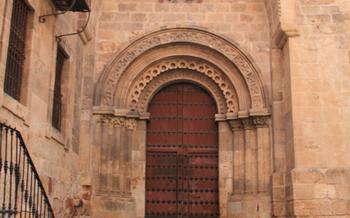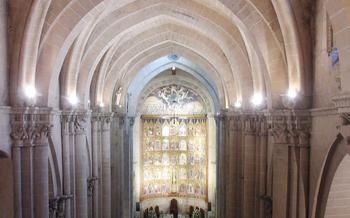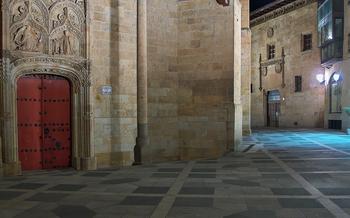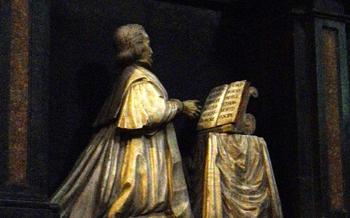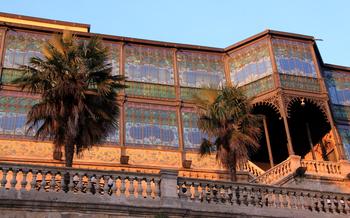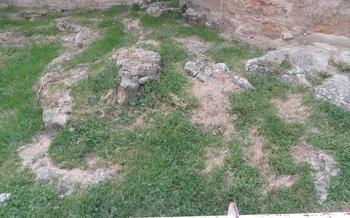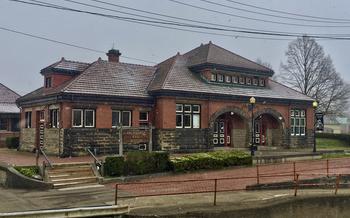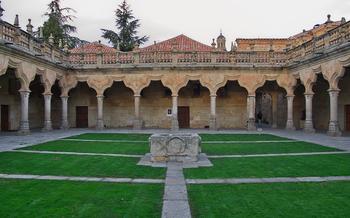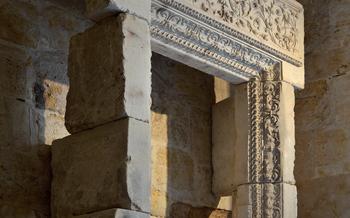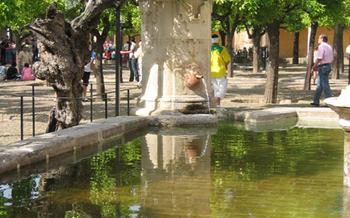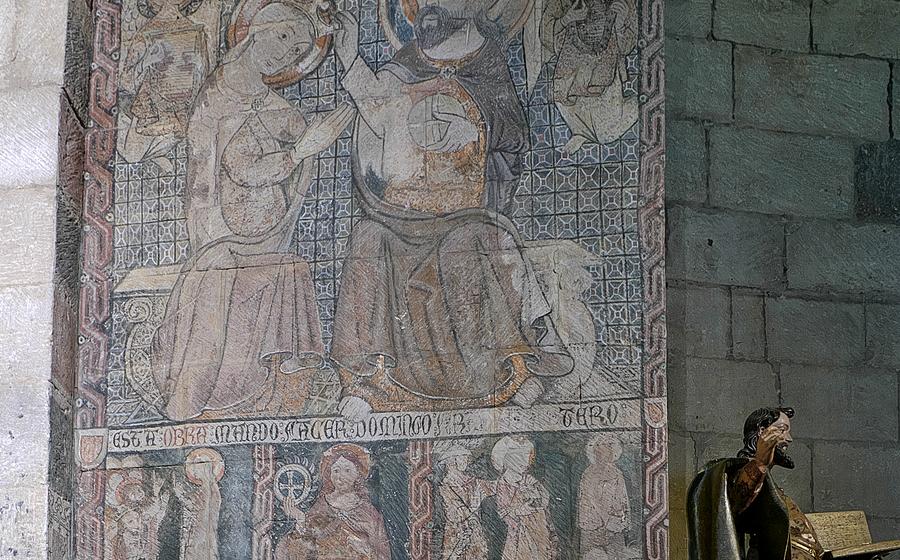
Church of San Marcos
- A City of Golden Stone
- Church of San Marcos
- Convent of San Marcos
- Plateresque Facade
- Museum of Salamanca
- Painting Collection
- Tapestry Collection
- Archaeological Collection
- Numismatic Collection
- Ceramics Collection
- Guided Tours
- Opening Hours
- Insider Tip
A City of Golden Stone
Salamanca is a city in western Spain, the capital of the province of Salamanca in the autonomous community of Castile and León. It is located on the banks of the Tormes River and is known for its well-preserved medieval center and its university, one of the oldest in Europe.
The city has a rich history, dating back to the Roman era when it was known as Salmantica. It was later ruled by the Visigoths and the Moors before being reconquered by the Christians in the 11th century. In the 13th century, the University of Salamanca was founded and the city became a major center of learning and culture.
Salamanca is a beautiful city with a unique architectural style that blends Romanesque, Gothic, and Renaissance elements. The city's most iconic landmark is the Plaza Mayor, a large square surrounded by arcades and balconies. Other notable sights include the Cathedral, the Convent of San Marcos, and the University of Salamanca.
Anecdote:
One of the most famous legends of Salamanca is the story of the bull of Salamanca. According to the legend, a bull was let loose in the city square every year and the students of the university would try to catch it. If they succeeded, they would be given a holiday. One year, a student named Martin Luther caught the bull and was given a holiday. He used the holiday to travel to Wittenberg, Germany, where he started the Protestant Reformation.
Church of San Marcos
The Church of San Marcos is an impressive example of Spanish Renaissance architecture and a must-see for any visitor to Salamanca. Its construction began in the 16th century and was completed in the 18th century. The church boasts a magnificent Plateresque facade, which is adorned with intricate carvings and sculptures. The facade depicts scenes from the life of Saint Mark, the patron saint of the church, as well as other biblical figures. The interior of the church features a single nave, with a barrel-vaulted ceiling. The main altarpiece is a stunning example of Baroque art and features a painting of the Virgin Mary with the Child Jesus. The church is located in the heart of Salamanca's historic center and is easily accessible on foot.
Anecdote:
The Church of San Marcos is said to have been built on the site of a Roman temple dedicated to the god Mars. When the Christians took over the city, they destroyed the temple and built a church in its place. However, the statue of Mars was spared and was placed in the new church. The statue can still be seen today in the church's sacristy.
Convent of San Marcos
The Convent of San Marcos is a former monastery in Salamanca, Spain. It was founded in the 12th century by the Knights Hospitaller, a military order that provided medical care to pilgrims and travelers. The convent is a beautiful example of Romanesque architecture, with a simple and elegant design. The church is the most impressive part of the convent, with its soaring nave and intricate carvings. The cloister is also a highlight, with its peaceful atmosphere and beautiful gardens.
Over the centuries, the convent was used for a variety of purposes. In the 16th century, it was converted into a hospital, and in the 19th century, it became a prison. In the 20th century, the convent was restored and converted into a museum.
Today, the Convent of San Marcos is one of the most popular tourist attractions in Salamanca. It is home to the Museum of Salamanca, which houses a collection of art and artifacts from the city's history. The convent is also a popular venue for concerts, exhibitions, and other events.
Anecdote:
In the 16th century, the Convent of San Marcos was visited by the famous Spanish writer Miguel de Cervantes. Cervantes was so impressed by the convent that he decided to use it as the setting for one of the stories in his novel Don Quixote.
Plateresque Facade
The Plateresque facade of the Church of San Marcos is a masterpiece of the Spanish Renaissance. It was built in the early 16th century by the architect Rodrigo Gil de Hontañón. The facade is made of sandstone and is decorated with intricate carvings of biblical scenes and figures.
The lower part of the facade is divided into three sections by two pilasters. The central section contains the main entrance to the church, which is flanked by two smaller doors. The upper part of the facade is divided into two sections by a horizontal cornice. The lower section contains a series of niches that contain statues of saints. The upper section contains a large window that is flanked by two smaller windows.
The sculptures on the facade are some of the finest examples of Plateresque art in Spain. They are carved with great detail and realism, and they depict a wide range of biblical scenes and figures. The most notable sculptures on the facade include the statue of Saint Mark, which is located above the main entrance to the church, and the statue of the Virgin Mary, which is located above the window in the upper section of the facade.
The symbolism of the facade is complex and multifaceted. The biblical scenes and figures that are depicted on the facade represent the history of salvation and the role of the Church in that history. The statues of saints represent the intercessors who can help us to achieve salvation. The window in the upper section of the facade represents the light of God that shines into the world.
Anecdote:
One of the most famous stories about the Church of San Marcos involves a young woman who was accused of witchcraft. She was brought to the church to be tried, and the judges ordered her to be burned at the stake. However, the woman was able to escape from the church and hide in the surrounding countryside. She was never found, and some people believe that she was protected by the saints who are depicted on the facade of the church.
Museum of Salamanca
The Museum of Salamanca is housed within the Convent of San Marcos. It was founded in 1941 as a successor to an earlier museum dating back to 184The museum possesses an impressive collection of archaeological artifacts, paintings, sculptures, and other works of art.
The museum showcases a wide range of archaeological treasures, including prehistoric tools, Roman mosaics, and medieval ceramics, offering a fascinating glimpse into the region's rich history. Among the highlights is a collection of Bronze Age swords, the largest of its kind in Spain. These meticulously crafted weapons provide insights into the region's metallurgy and warfare during ancient times.
The museum's collection of paintings, on the other hand, spans various artistic periods and styles. Visitors can admire works by renowned Spanish masters such as El Greco, Francisco de Goya, and Diego Velázquez. These paintings showcase the evolution of Spanish art, from the Renaissance to the Baroque and beyond.
Painting Collection
The Museum of Salamanca boasts an impressive collection of paintings, featuring works from the Middle Ages to the 20th century. Visitors can admire masterpieces from renowned Spanish artists such as Francisco de Goya, El Greco, Diego Velázquez, and Bartolomé Esteban Murillo. The collection is particularly rich in religious art, showcasing stunning depictions of biblical scenes and saints.
One of the highlights of the collection is "The Martyrdom of Saint Bartholomew" by José de Ribera, a powerful and moving portrayal of the saint's suffering. Another must-see is "The Annunciation" by El Greco, a luminous and ethereal interpretation of the biblical event. Visitors will also find a significant number of portraits, landscapes, and still lifes, offering a glimpse into the diverse styles and techniques of Spanish painting throughout the centuries.
Tapestry Collection
Housed within the convent's walls is an impressive collection of tapestries, each a masterpiece of textile art. These intricate tapestries, woven with vibrant threads, depict scenes from history, mythology, and religion, offering a glimpse into the artistry and craftsmanship of past centuries.
The collection showcases tapestries from various periods, including the Renaissance and Baroque eras. One of the highlights is a series of tapestries depicting the life of Christ, with each panel narrating a different event from his birth to his resurrection. Another notable tapestry depicts the Battle of Lepanto, a significant naval victory for the Spanish Empire in the 16th century.
These tapestries not only serve as decorative elements but also provide valuable insights into the social, cultural, and religious beliefs of the time. They offer a unique perspective on the artistic expressions and storytelling traditions of past generations.
Anecdote:
During the Spanish Civil War, the tapestries were hidden away to protect them from damage and destruction. They were carefully rolled up and stored in a secret location, safe from the ravages of war. After the conflict ended, the tapestries were returned to the convent, where they were restored and put on display once again.
Archaeological Collection
The Archaeological Collection at the Museum of Salamanca offers a fascinating glimpse into the rich history of the region, from prehistoric times to the Middle Ages. The collection is divided into three sections: Pre-Roman, Roman, and Medieval.
Pre-Roman: This section features artifacts from the Paleolithic and Neolithic periods, including stone tools, pottery, and jewelry. Of particular interest is a collection of Bronze Age weapons and tools, which provide insights into the daily lives of the region's earliest inhabitants.
Roman: The Roman section showcases a wide range of artifacts from the Roman Empire, including coins, pottery, and sculptures. Highlights include a well-preserved Roman mosaic depicting a scene from mythology, as well as a collection of Roman glass and metalwork.
Medieval: The Medieval section contains artifacts from the Visigothic and Islamic periods, as well as from the Christian reconquest of the region. Notable pieces include a collection of Visigothic jewelry, a set of Islamic pottery, and a sword from the Battle of Las Navas de Tolosa.
Numismatic Collection
The numismatic collection at the Museum of Salamanca is a treasure trove of ancient coins, offering a glimpse into the rich history of the region. The collection boasts an impressive array of Roman coins, dating from the Republic to the Empire. These coins provide valuable insights into the monetary system and economy of ancient Rome, as well as the political and cultural developments of the period.
In addition to the Roman coins, the collection also includes a significant number of Visigothic coins, minted during the Visigothic Kingdom of Hispania. These coins showcase the unique artistic style of the Visigoths, blending Roman and Germanic influences. The collection also features a variety of medieval coins, issued by the Christian kingdoms that emerged after the fall of the Visigothic Kingdom.
The numismatic collection at the Museum of Salamanca is a valuable resource for scholars and history enthusiasts alike, providing a deeper understanding of the region's past through the study of its coinage.
Ceramics Collection
The Museum of Salamanca also houses a remarkable collection of ceramics, showcasing a wide range of pottery from different eras, including Roman, medieval, and modern periods. The Roman pottery collection features various vessels, including amphorae, cooking pots, and tableware, providing a glimpse into the daily lives and dining habits of the ancient Romans.
The medieval pottery, on the other hand, is characterized by its unique glazing techniques and intricate decorations, often depicting religious scenes or mythical creatures. Visitors can admire glazed tiles, plates, and jugs, each telling a story of the artistic and cultural influences of the Middle Ages.
The modern pottery collection represents the revival of ceramic art in Salamanca and features works by renowned local artists. These contemporary pieces showcase innovative designs, vibrant colors, and experimental forms, reflecting the evolving artistic landscape of the city.
Anecdote
One of the most captivating pieces in the ceramics collection is a medieval jug known as the "Jug of the Seven Deadly Sins." This elaborately decorated jug features seven panels, each depicting a different sin, such as pride, greed, and envy. According to legend, the jug was created by a monk who wanted to remind his fellow brothers of the dangers of succumbing to temptation.
Guided Tours
Guided tours of the Church of San Marcos are available in Spanish, English, and French. Tours typically last for about an hour and cover the history, architecture, and art of the church. The cost of a guided tour is 5 euros per person.
Insider tip: Book your tour in advance, especially if you are visiting during the busy summer months. You can book your tour online or by calling the church office.
Opening Hours
The Church of San Marcos is open to the public daily, but the hours vary depending on the season. In the summer, from April 1st to September 30th, the church is open from 9:00 am to 8:00 pm. In the winter, from October 1st to March 31st, the church is open from 9:00 am to 6:00 pm. On holidays, the church is open from 10:00 am to 2:00 pm.
Insider Tip:
To avoid the crowds, it is best to visit the church early in the morning or late in the afternoon. The church is also closed for lunch from 1:00 pm to 2:00 pm, so it is best to plan your visit accordingly.
Insider Tip
- Photography: Flash photography is not allowed inside the church.
- Souvenirs: The museum shop sells a variety of souvenirs, including books, postcards, and replicas of the church's artwork.
- Accessibility: The church is wheelchair accessible.
- Insider Tip: To avoid the crowds, visit the church early in the morning or late in the afternoon.
